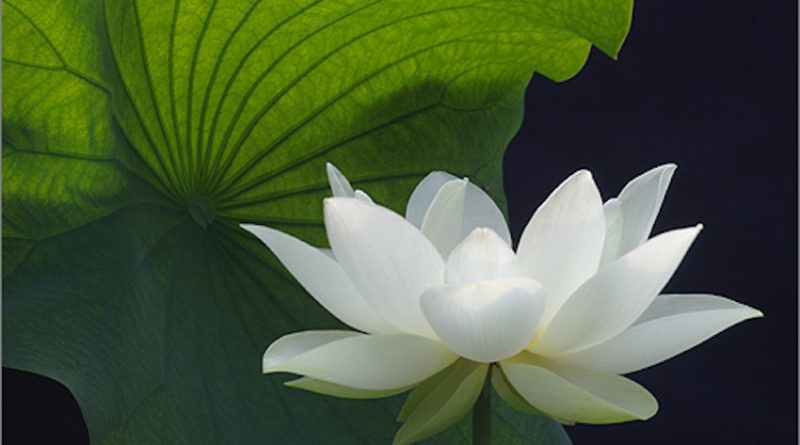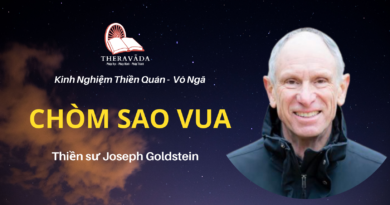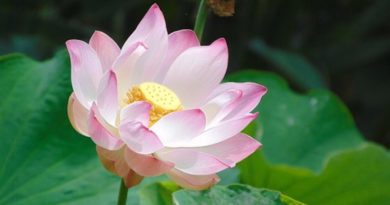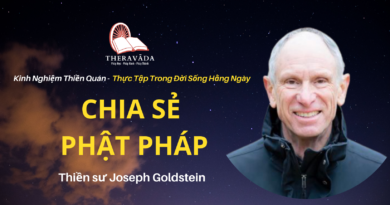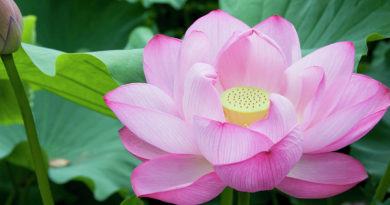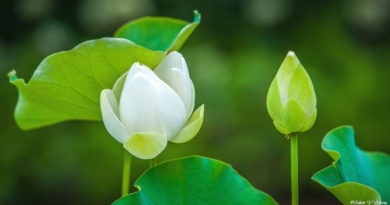Buddhist Outlook On Daily Life – 6. The Buddha
BUDDHIST OUTLOOK ON DAILY LIFE – 6. THE BUDDHA
In the Buddhist temples of Thailand we see people paying respect in front of the Buddha statue by kneeling and touching the floor three times with their hands and head. Those who have just arrived in Thailand may wonder whether this way of paying respect is a form of prayer or whether it has another meaning. Buddhists in Thailand express in this way their confidence in the ‘Three Gems’: the Buddha, the Dhamma and the Sangha. They take their refuge in the ‘Three Gems’.
The first Gem is the Buddha. When people take their refuge in the Buddha, they say the following words in Pali: ‘Buddham saranam gacchami’, which means, ‘I go for refuge to the Buddha. ‘What is the meaning of the word ‘Buddha’? The ‘Illustrator of Ultimate Meaning’ (the ‘Paramatthajotika‘, a commentary to the Khuddaka Nikaya) explains (in the commentary to the ‘Three Refuges’ of the ‘Minor Readings’) the meaning of the word ‘Buddha’:
… and this is said, ‘Buddha: in what sense buddha? He is the discoverer (bujjhita) of the Truths, thus he is enlightened (buddha). He is the enlightener (bodheta) of the generation, thus he is enlightened. He is enlightened by omniscience, enlightened by seeing all, enlightened without being led by others … Buddha: this is not a name made by a mother, made by a father … this (name) “Buddha”, which signifies final liberation, is a realistic description of Enlightened Ones. Blessed Ones, together with their obtainment of omniscient knowledge at the root of an enlightenment (tree). ‘
The Buddha is the discoverer of the truth. What is the truth the Buddha discovered all by himself? ‘He is enlightened by omniscience, enlightened by seeing all ‘ the Paramatthajotika commentary says. He had developed the wisdom to see and to experience the truth of all things. Everything in life is impermanent and thus it is unsatisfactory. People suffer from old age, sickness and death. In spite of this truth people still cling to the things in and around themselves. Thus they are not able to see reality. The Buddha experienced that all phenomena which arise fall away immediately. He would not cling to anything at all.
For us it is difficult to experience the truth of impermanence. Nama and rupa arise and fall away all the time, but one cannot experience this if one’s wisdom is not developed. It is difficult to be aware often of realities when they appear and to realize what they are: only nama and rupa, phenomena which are impermanent and not self. The more we realize how difficult it is to see things as they are, the more we understand that the Buddha’s wisdom must have been of the highest degree.
The Buddha taught that everything in life is dukkha. Dukkha literally means misery of suffering. However, the experience of dukkha is much deeper than a feeling of sorrow or contemplation about suffering. The experience of dukkha is the experience of the impermanence of the nama and rupa in our life and the realization that none of these phenomena is true happiness. Some people may think that pondering over this truth is already the experience of dukkha. However, one does not know the truth if one merely thinks about it. When one directly experiences the arising and falling away of nama and rupa, one will come to know the truth of dukkha. Then one will learn to be less attached to nama and rupa.
In the ‘Greater Discourse of a Full Moon’ (Mahapunnama-sutta, Majjhima Nikaya III, Devadaha-vagga) we read that the Buddha asked the monks:
‘What do you think about this, monks? Is material shape permanent or impermanent? ‘
‘Impermanent, revered sir. ‘
‘But is what is impermanent painful or is it pleasant? ‘
‘Painful, revered sir. ‘
‘And is it right to regard that which is impermanent, suffering, liable to change, as, “This is mine, this am I, this is myself”? ‘
‘No, revered sir. ‘
The Buddha asked the same question about mental phenomena.
Everything in our life is impermanent. Even what we call happiness is impermanent- it is only a mental phenomenon which arises and falls away immediately. How can that which arises and falls away as soon as it has arisen be real happiness? Everything in life, even happiness, is therefore dukkha or unsatisfactory. What arises and falls away we cannot take for self;everything is anatta or ‘not self’. Impermanence, dukkha and anatta are three aspects of the same truth, the truth about all things in and around ourselves. It may take us a long time before we can experience things as they really are. We should always be aware of the nama and rupa which appear, such as, for example, seeing, hearing or thinking at this moment.
The Buddha was always mindful and clearly conscious. He did not have ignorance about any reality. When we realize how difficult mindfulness is, we deeply respect the great wisdom of the Buddha. The Buddha is called the ‘Awakened One’, because he is awakened to the truth. We read in the ‘Sela-sutta’ (Majjhima Nikaya II, Brahmana-vagga) that the Buddha said to Sela:
‘What is to be known is known by me, and what is to be developed is developed, what is to be got rid of has been got rid of- therefore, brahman, am I Awake. ‘
The Buddha had, by his enlightenment, attained the greatest purity. He had completely eradicated all defilements. The Buddha became enlightened in this world. He taught that people in this world can develop such a high degree of wisdom that they can become completely free form defilements and latent tendencies. The more we know about our own subtle defilements and the more we see how deeply rooted the clinging to a self is, the more we realize the high degree of the Buddha’s purity.
The Buddha was full of compassion for everybody. The fact that the Buddha was free form defilements does not mean that he did not want to help the world or that he did not want to think of those who still had defilements. People are inclined to think that Buddhism makes people neglectful of their duties towards others and that it makes them self-centered. On the contrary, Buddhism enables one more fully to perform one’s duties and to serve other people in a more unselfish way.
The Buddha attained enlightenment for the happiness of the world. In the ‘Anguttara Nikaya’ (Book of the Ones, Chapter XIII) we read that the Buddha said to the monks:
Monks, there is one person whose birth into the world is for the welfare of many folk, for the happiness of many folk; who is born out of compassion for the world, for the profit, welfare and happiness of devas and mankind. Who is that one person? It is a Tathagata who is Arahant, a fully Enlightened One. This, monks, is that one person.
The more one understands the Buddha’s teachings, the more one is impressed by his compassion for everybody. The Buddha knew what it meant to be free from all sorrow. Therefore he helped other people to attain this freedom as well. One can help other people by kindness, by generosity, and in many other ways. The most precious thing one can give others is to show them the way to true peace and happiness. The Buddha proved his great compassion to people in teaching them Dhamma.
When Buddhists pay respect to the Buddha statue they do not pray to a Buddha in heaven, since the Buddha passed away completely. Buddhists pay respect to the Buddha statue because they think with deep reverence and gratefulness of his virtues: of his wisdom, his purity and his compassion. When one speaks of virtues one usually thinks of good qualities in someone’s character. There are many degrees of good qualities however. When the wisdom of him who follows the eightfold Path is developed to such an extent that he can attain enlightenment, then his way of life will have become purer and his compassion for others deeper. Wisdom is not only knowing the truth in theory, but realizing the truth in one’s life as well. The virtues of the Buddha were developed to such a degree that he not only became enlightened without the help of a teacher, but was also able to teach the truth to others, so that by following the Path they could attain enlightenment.
There were other Buddhas before Gotama the Buddha. All Buddhas find the truth by themselves, without being led by others. However, there are two different kinds of Buddha: the ‘Sammasambuddha‘ and the ‘Pacceka Buddha’ or ‘Silent Buddha’. The Pacceka Buddha has not accumulated virtues to the same extent as the Sammasambuddha and thus he is not as qualified in teaching other people as the Sammasambuddha. Gotama the Buddha was a Sammasambuddha. There cannot be more than one Sammasambuddha in a ‘Buddha era’; neither can there be any Pacceka Buddhas. The Buddha era in which we are living will be terminated when the Buddha’s teachings have disappeared completely. The Buddha foretold that the further one is away from the time he lived, the more his teachings will be misinterpreted anc corrupted. Some time after his teachings have disappeared completely there will be the next Buddha and so the next Buddha era. The next Buddha will discover the truth again and he will teach other people the way to enlightenment.
Buddhists take refuge in the Buddha. What does the word ‘refuge’ mean? The Paramatthajotika commentary speaks about the meaning of the word ‘refuge’:
… When people have gone for refuge, then by that very going for refuge it combats, dispels, carries off, and stops, their fear, anguish, suffering, (risk of) unhappy destination (on rebirth), and defilement … the going for refuge is the arising of knowledge, with confidence therein and giving preponderance thereto, from which defilement is eliminated and eradicated, and which occurs in the mode of taking that as the highest value…
Going for refuge to the Buddha does not mean that the Buddha can eradicate people’s defilements. We read in the ‘Maha-Parinibbana-sutta‘ (Digha Nikaya II, Chapter II) that, before his death, the Buddha said to Ananda:
Now I am frail, Ananda, old, aged, far gone in years. This is my eightieth year, and my life is spent… Therefore, Ananda, be an island to yourself, a refuge to yourself, seeking no external refuge; with Dhamma as your island, Dhamma as your refuge, seeking no other refuge.
The Buddha then explained that taking one’s refuge in the Dhamma means being mindful of nama and rupa. This is the eightfold Path which leads to nibbana. One can depend only on oneself in following this Path, not on any one else.
The Buddha said that the Dhamma and the Vinaya would be his successor. Today the Buddha is no longer with us, but one takes refuge in the Buddha when one has confidence in his teachings and one considers it the most important thing in life to practise what he taught.

